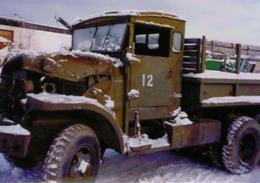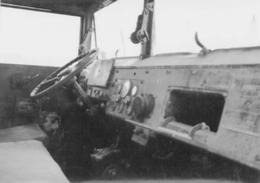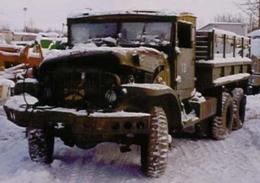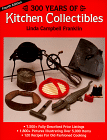
David Castle's Army Kitchen Truck
Purchasing a M211 2-1/2-Ton Truck and Getting It Home
By David Castle and Steve Karoly
It has been a long -- and at times exhausting -- journey from locating a suitable truck to exhibiting a fully restored GMC M211 2-1/2-ton, 6X6 kitchen truck to the public. After a three-year search, I found a military surplus M211 truck in Anchorage, Alaska in November 1993.
I joined the Alaska Territorial Cavalry (Motorized) in 1990 with the idea of finding and restoring a Willys Jeep. I was looking for a jeep when George Glazier, a member of the club, bought an M211 from a guy who was going to convert it into a hunting rig. The truck brought back lot of memories when I saw it. Although I have seen countless 2-1/2-ton trucks in my 29-year National Guard career, Glaiserís M211 reminded me most of truck that I drove when I first enlisted in the Virginia Army National Guard. I then knew that I wanted to restore a M211 back to a kitchen truck.
Locating a M211 truck to restore
 I tried in vain to talk Glazier out of the truck. He
would not sell it. But, as it turned out, Glazier served as my point
man in my search for a M211. As an employee of Anchorage Refuse, he
drove a garbage truck throughout the city every day. He came to me
about a month later and told me that while he was emptying a Dumpster
at a local construction yard, he came across a M211 that was in pretty
good shape. And the truck was for sale.
I tried in vain to talk Glazier out of the truck. He
would not sell it. But, as it turned out, Glazier served as my point
man in my search for a M211. As an employee of Anchorage Refuse, he
drove a garbage truck throughout the city every day. He came to me
about a month later and told me that while he was emptying a Dumpster
at a local construction yard, he came across a M211 that was in pretty
good shape. And the truck was for sale.
Needless to say I was right on top of it and went down to the Walsky Construction lot on the next day, November 8, 1993, to look at the truck. I climbed all over and under the truck, looking at everything that would stop me from buying the truck. The hood had major dent in it, most of the glass was broken out of it, and the right side bumper had a rusted out metal plate on it and needed to be straightened. The interior of the cab was in excellent condition other than some rust. The personnel heater was there, but it seemed to be damaged.
 The mechanic at the yard told me that the truck was
only used to move things around the yard. The real big plus to me was
that the truck had not been cut on: The inside of the cab and the bed
was intact and all the running gear was there except for the emergency
brake on the transmission.
The mechanic at the yard told me that the truck was
only used to move things around the yard. The real big plus to me was
that the truck had not been cut on: The inside of the cab and the bed
was intact and all the running gear was there except for the emergency
brake on the transmission.
The next day I went back and talked to Mr. Walsky, the owner of Walsky Construction Company. He was asking $2000.00 for the truck. We haggled with for about a week and brought the purchase price down to $1,300.00. That is better than would have ever thought.
Several days later, I went to the Alaska Division of Motor Vehicles and registered the title in my name. Under the Alaska vehicle code, vehicles that are 30 or more years in age and are only driven on the highway for historical exhibition can be registered as a historic vehicle. Since my M211 met the criteria, DMV assigned it historic vehicle license plate number HW 464. The nice thing is that after paying the modest initial registration fee of $15.00, I do not have to renew my registration each year.
Getting the truck home
On December 11, 1993, armed with copy of the 1955 technical manual for the truck that Alan Bransley had given me, Bransley, Glazier I drove to the Walsky Construction yard to pick up the M211 in five-degree weather. With two friends from the Alaska Territorial Cavalry, we were prepared to drive the truck to my home or two it if we could not get it started.
Glazier brought a truck that had a tow bar that was big enough to tow the M211 if necessary. We checked all of fluid levels in the truck, drained the old gas and filled the tank with fresh gas. We tried to put two new truck batteries in the battery compartment, but they would not fit. So we tied them onto the fenders and hooked them up.
Then came the moment of truth -- would the engine start? I got up in the cab while Bransley primed the carburetor and Glazier crossed his fingers. I cut the switch on, pulled the starter switch and it turned over. About the tenth time, the 302 cubic-inch engine started. We shouted.

It took 10 months of weekends and evenings to locate parts and find the time to work on the truck. Because I did not have an indoor location to work on the M211, I could only work on days when the temperature was above 20-degrees. I made little progress until the next summer. My persistence paid off. I showed the truck for the first time at an event sponsored by the Antique Auto Mashers of Alaska in September 1994.
Return to David Castle's Restored Army Kitchen Truck
February 2000
| Bulletin Board | Keyword Search |
| Bookstore | Links |
| About Us | Recent Additions |

